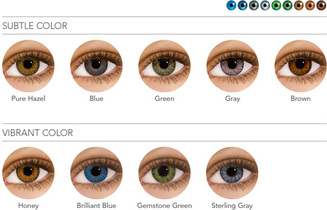contact lenses
|
New Advances in Contacts
New advances make contacts an easy choice With the advances in contact lenses over the past decade, patients are faced with many options in their efforts to correct their vision. This is where Dr. Redfield can help you in the decision making process so the contact lens choice you make is the right one. |
Types of Contacts
Soft contact lenses are made from flexible, water-absorbent plastics. Some soft lenses are designed to be replaced daily, weekly or every other week depending on the recommendation of your Doctor of Optometry. They are usually easy to insert and fit comfortably and securely.
Soft contact lenses are made from flexible, water-absorbent plastics. Some soft lenses are designed to be replaced daily, weekly or every other week depending on the recommendation of your Doctor of Optometry. They are usually easy to insert and fit comfortably and securely.
Rigid gas permeable (RGP) lenses are made of special, firm plastic that allows the passage of oxygen and other gases. These lenses are very durable and typically last longer than soft lenses. RGP lenses give you crisp vision and are often recommended for people with high degrees of astigmatism (blurry vision at all distances). While they may take a little longer to get used to, regular wearers find them to be comfortable and the visual acuity outstanding.
Contact Lens Choices
Daily wear contacts are removed each day for cleaning and should be taken out before sleeping. They require a daily maintenance schedule to keep the lenses clean and free from deposit build up and bacteria.
Extended wear contacts can be worn continuously for up to 30 days and nights and are designed with breathable materials so your eyes stay healthy and your vision stays clear.
Daily wear contacts are removed each day for cleaning and should be taken out before sleeping. They require a daily maintenance schedule to keep the lenses clean and free from deposit build up and bacteria.
Extended wear contacts can be worn continuously for up to 30 days and nights and are designed with breathable materials so your eyes stay healthy and your vision stays clear.
Disposable soft contacts are rapidly growing in popularity because they can be worn for a single day or up to one year, depending on the wearing schedule prescribed by your Doctor of Optometry. The more your contacts are replaced, the smaller the risk of long-term deposits that can build up on the lenses. Disposables can be purchased in multi-packs for a continuous supply of fresh lenses. Many patients enjoy the comfort of disposable lenses in addition to convenience, clear vision and healthy eyes. They're easy to insert and fit comfortably and securely. With disposable contacts, the hassle of caring for daily wear contacts is eliminated.
|
Colored contacts
If you've ever thought of enhancing or changing your eye color, consider another popular trend with colored contacts. The color is seen on your eye, but does not affect the color of what you see. The advancement in the color quality of the lenses today make them look as natural as Mother Nature intended. |
Toric contacts
Toric contact lenses are designed for patients who have astigmatism, an eye condition which results in blurry vision at all distances. Toric contact lenses are designed to have two powers in them, created with curvatures at different angles (one for astigmatism, the other for either nearsightedness or farsightedness). There's also a mechanism to keep the contact lens relatively stable on the eye when you blink or look around. To provide crisp vision, toric contact lenses cannot rotate on your eye.
Toric contact lenses are designed for patients who have astigmatism, an eye condition which results in blurry vision at all distances. Toric contact lenses are designed to have two powers in them, created with curvatures at different angles (one for astigmatism, the other for either nearsightedness or farsightedness). There's also a mechanism to keep the contact lens relatively stable on the eye when you blink or look around. To provide crisp vision, toric contact lenses cannot rotate on your eye.
Tips for proper care of contacts
- Visit your eye doctor every year for a complete eye examination.
- If eyes become red or irritated, remove the lenses immediately and consult your doctor.
- Remember "CRD": Cleanse, Rinse, Disinfect your lenses after removal and before wearing them again.
- Always wash and rinse your hands carefully before handling your lenses.
- Don't use saliva to clean your lenses.
- Solutions can become contaminated through contact with lenses.
- Do not let the bottle tip touch any surface including your contact lenses.
- Clean, rinse and air-dry your lens case each time lenses are removed to avoid bacterial growth.
- Replace contacts regularly because they wear out over time. Throw away disposable lenses after the recommended wearing period.
- Keep your eye looking pretty and healthy by putting your contacts on before applying makeup and taking your lenses off before removing makeup.

